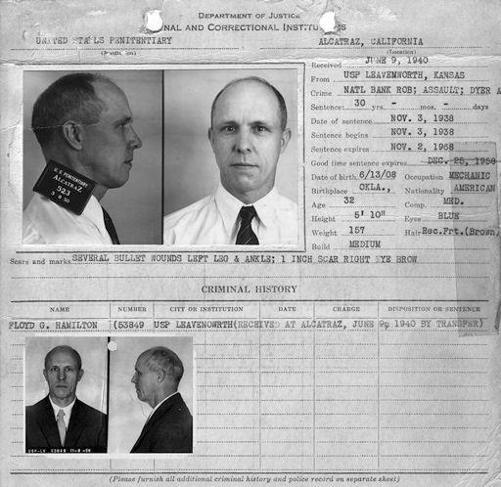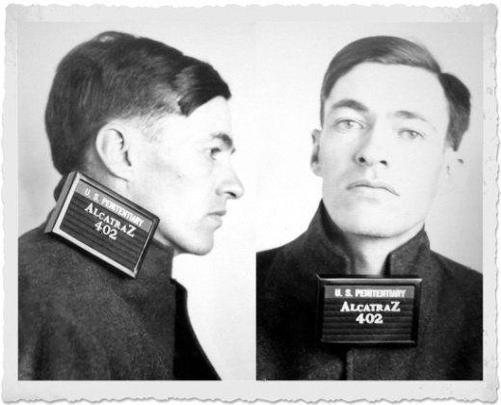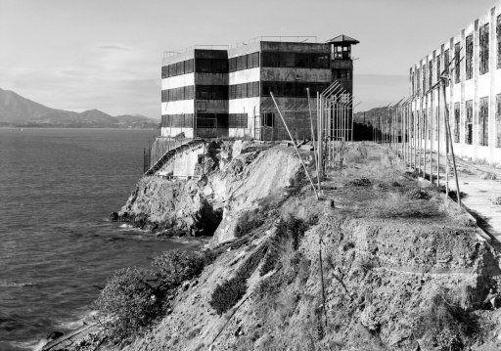Floyd Garland Hamilton

Floyd Garland Hamilton
The third accomplice in the 1943 escape attempt was one of the most famous inmates ever to inhabit a small five-by-nine-foot cell at Alcatraz. He had reached the top of the FBI’s most wanted list, and had chauffeured one of the most well known crime couples of the 1930’s, Bonnie and Clyde. His brother Raymond had been a member of the Barrow-Parker Gang and later met his death by electrocution for his role in an escape from a Huntsville prison, which had ultimately resulted in an officer’s death. Floyd and his brother Ray had grown up with Bonnie and Clyde in a small town near Dallas, Texas. Newspapers of the era characterized Floyd Hamilton as a suspect in almost every act of violence that occurred in the Dallas area during the 1930’s.
Floyd Hamilton was born on June 30, 1908 in Henrietta, Okalahoma. He was the second in a family of six children, and his parents were divorced. Records indicate that he was raised in a normal family setting, attended Sunday school, and left home at the age of nineteen to marry a young woman named Mildred Stract. During the early years of his marriage, Floyd worked as a pipe fitter in an oil refinery, but he later lost his employment when the plant closed down.
Floyd then began a crime spree that would eventually place him at the top of the FBI’s Ten Most Wanted List. He worked as a getaway driver for Bonnie and Clyde, and later teamed up with Alcatraz alumnus Ted Huron Walters, who would himself attempt to escape from The Rock in another incident. Both men would engage in several other robberies, with targets including a Coca-Cola Bottling Company. This was the heist that would ultimately lead to Hamilton’s arrest in Dallas on August 21, 1938.
Hamilton was incarcerated at Leavenworth, and would be recommended for transfer to Alcatraz in January of 1940, after attempting to enlist a released inmate to smuggle weapons and hacksaw blades into the institution. His Leavenworth report also stated that he and a few other inmates had attempted to have a shotgun and shells fabricated in the machine shop for use in an escape. He arrived at Alcatraz several months later on June 9, 1940, as inmate #AZ-523.

Floyd Hamilton’s conduct reports from Alcatraz.
Fred Hunter

Fred Hunter
Fred Hunter, another “public enemy” and former member of the Karpis-Barker Gang, was also an accomplice to the planned escape. Hunter was serving twenty-five years for his involvement in the kidnapping of William A. Hamm Jr., the president of Hamm’s Brewing Company, and Edward G. Bremer, a prominent community leader and the President of the Commercial State Bank in Minnesota. His criminal history is covered in the chapter describing the Barker Escape of January 1939. There were rumors from Hunter that the group of inmates had been prepared for an escape attempt nearly two weeks earlier, but Boarman had allegedly insisted that they wait for the right fog conditions so that they could enter the bay without being seen.
The Escape

The Model Industries Building.
At approximately 10:00 a.m. on April 13, 1943, conditions seemed ideal for the escape, with densely layered fog enveloping the island. It was later speculated that the inmates had cut through one of the steel-mesh window guards in the old Mat Shop during the previous weeks, hiding their work by using grease mixed with other agents to fill in the tiny sawed gaps. Custodial Officer George Smith was busy supervising the inmates who were mixing concrete. He was called to the yard gate to escort four other inmates who were reporting to their work assignments. When Smith returned only a short time later, he noticed that Hunter was the only prisoner at his position near the entrance to the Mat Shop. Officer Smith was quickly intercepted by Hamilton, who forcefully grabbed him by the arm, while Boarman stepped into his path gesturing deadly threats with a knife and hammer. When Smith resisted, he was beaten into submission by all four of the inmates and then bound and gagged.
Captain of the Guards, Henry Weinhold, known to many of the inmates as “Bullethead,” was a tough former Marine making his routine rounds. Not suspecting any trouble, he entered the Mat Shop and was quickly captured by the inmates who by were now stripped down to their underwear. Weinhold resisted and nearly managed to grasp one of Boarman’s weapons when the other inmates tackled him, dealing several painful blows using a carpenter’s hammer to his extremities. He too was incapacitated, then tightly bound and gagged and laid beside Officer Smith.
Hamilton was the first to climb through the window, and he managed to maintain a grip on the remaining security bars while the other inmates passed out a wooden filling guide to be used as a ramp from the window to the barbed wired security fencing. After maneuvering the makeshift plank properly into place, Hamilton was passed a large rolled section of canvas to drape over the barbed-wired fencing. Boarman and Brest now stripped to their underwear and belts (which they planned to secure to the canisters to keep them afloat) and smeared their bodies with engine grease as insulation.
Boarman and Brest attempted to maneuver the float canisters through the window without success, so they were forced to leave them behind, along with the clothing they contained. One by one, the men climbed through the window, negotiated the wire fencing, and then hurried down to the rocky shore. Hunter had injured himself when dropping from the fence and he took refuge in a small island cave that was recessed under the industry buildings. The cave was dark and littered with discarded tires, and was flooded with varying levels of seawater depending on the tide levels. Boarman, Brest, and Hamilton each started their swim to freedom, partially obscured by the breaking fog.
Meanwhile Officer Weinhold had succeeded in loosening his gag, and started yelling for help, but due to the noise of the loud machinery in the Industries, his cries went unheard. At about the same time, Officer Frank L. Johnson, who was assigned to the tower atop the Model Shop, was attempting to reach Smith and had already contacted Cliff Fish in the Armory. Fish, who was just being relieved from duty, responded to the Industries to investigate the problem, accompanied by Phil Bergen and Earl Long. Officer Johnson stepped outside of the tower booth, and immediately spotted several figures in the water, swimming away from the island. Smith, while unable to undo his gag, was able to move his body against Weinhold, who then managed to maneuver Smith’s whistle into his mouth. Weinhold started frantically blowing the shrill whistle, which was clearly audible from Johnson’s post.
Lifting his rifle, Johnson strained to peer into the target site as several faint figures continued to advance away from the island in the foggy seascape. Watching the figures move in rhythm with the sea, he drew his grip tight, and squeezed the trigger until the pressure of the spring gave way to a ragging shot. He repeated the process, sighting each moving figure, then firing his Springfield .30-06. Each round released a caustic smell of burnt gunpowder mixed with the misty salt air. Brest and Boarman saw the geyser-like splash patterns in the water around them, accompanied by the distant sharp cracking sound of a high-powered rifle. After each round was fired, silence would drape the water until the next blast racked the air. As Brest and Boarman swam almost side-by-side a few hundred yards from shore, the sounds of Boarman’s thrashing suddenly stopped. As Brest reached out to examine the now silent form of his fellow inmate, the water surrounding them started to turn an eerie red.